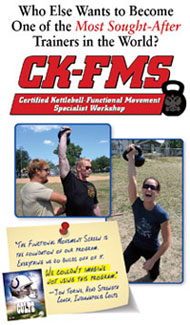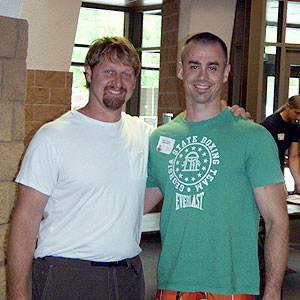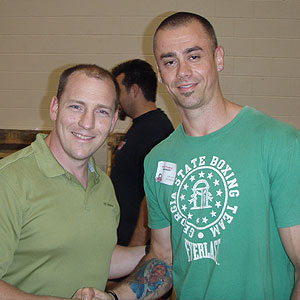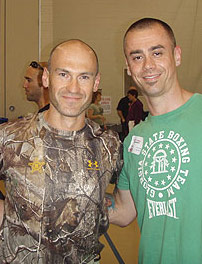What is the CK-FMS?

Specifically, the Functional Movement Screen is a ranking and grading system scientifically created to document movement patterns that are key to normal function.
By screening these patterns, we successfully and quickly identify functional limitations and asymmetries. Basic movement pattern limitations can reduce the effects of functional training, physical conditioning, and distort proprioception (body awareness).
At the heart of the system is the Functional Movement Screen Score, which helps us target the real problem for any individual and track their progress with real precision. The scoring system is directly linked to the most beneficial corrective exercises to restore mechanically sound movement patterns.
The screen allows us to identify physical imbalances or weaknesses and strengthen them with simple corrective exercises and patterning and identify current injury trends and stats as they relate to the prevention of non-contact injuries. The focus of the system is to build durability or health first before fitness and performance. As they say you can’t fire a cannonball from a canoe. The CK-FMS is focused on not building “fitness on dysfunction”.
Most athletes do not begin strength and conditioning programs or rehabilitative programs by determining if they have adequate movement patterns. The FMS screen pinpoints weak links in movement patterns and alleviate them. If that weak link is not identified the body will compensate, causing inefficient and dysfunctional limitations. Missing this link causes the type of inefficiency that can cause a decrease in performance and an increase in injuries. The idea is to individualize training based on that athlete’s weakest link. By looking at the movement patterns rather than just one area (a mistake that physiotherapists still make) that weak link can be identified and then corrective strategies can be applied to the pattern to correct it-and with long term results.
The movement screen is intended to:
- Identify individuals at risk, who attempting to maintain or increase activity level.
- Assist in program design by systematically using corrective exercise and strategies to normalize or improve fundamental movement patterns.
- Provide a systematic tool to monitor progress and movement pattern development in the presences of changing fitness levels
- Create a functional movement baseline which allows rating and ranking movement for statistical observation.
The system consists of the FMS or functional movement screen, core training and reactive neuromuscular training (RNT). It also provides us with a clearance list, colour coding exercises in red, yellow and green that depending on your FMS score, and are particular exercises or activities should be avoided that will increase the risk or delay the process of the corrective strategies
The CK-FMS is run by these two amazing individuals below.

About Gray Cook
Gray Cook—MS, PT, OCS, CSCS, RKC
- Lectures nationally and internationally in the fields of physical therapy, sports medicine and performance enhancement
- Consultant for many universities and pro sports teams in all four major sports
- Author of the bestselling Athletic Body in Balance and numerous FMS DVDs.
- Board Certified Orthopedic Clinical Specialist with American Physical Therapy Association
- Certified Strength and Conditioning Specialist with the National Strength and Conditioning Association
- Level 1 coach with US Weight Lifting Federation
- Practices physical therapy in Virginia and continues to publish in all areas relating to rehab and exercise

About Brett Jones
Brett Jones—Master RKC, MS, CSCS
- Strength and conditioning professional with over 20 years of combined athletic training and conditioning experience.
- As a former certified Athletic Trainer, with a B.S. degree in Sports Medicine, has an in-depth knowledge of orthopedic evaluation and rehabilitation and have worked with athletes of all levels.
- Masters Degree in the field of Rehabilitation Science from Clarion University of Pennsylvania. Providing expertise in behavior modification.
- Certified Strength and Conditioning Specialist through the National Strength and Conditioning Association in 1999.
- Co-author with Gray Cook of the FMS DVD Secrets Series and as a Master RKC who has worked closely with Gray Cook in learning how to integrate Corrective Strategies and Movement Screening into RKC training, Brett Jones is uniquely qualified to deliver this highly practical, hands-on method to dramatically improve your own and other's physical performance.
- Co-author of the highly acclaimed Kettlebell Basics for Strength Coaches and Personal Trainers 2-DVD set.
- Has delivered numerous kettlebell workshops in both the US and UK.
Who Uses the CK-FMS
The CK-FMS has been used with a large number of US sporting teams including a number of NFL and NHL teams. What they discovered is that a FMS score of less than 14 lead to an increased injury likelihood rate of 50% and that meant it had climbed from the normative figure of 15% likelihood of injury every time one of those players stepped out on the field!
The FMS has also been used to look at military entrance programs as a biomarker to indicate the potential pass rate of participants. The data has been collated and can be found in the journals of the American Medical Society of Sports Medicine titled: Functional Movement Screening: A novel Tool fro Injury Risk Stratification of Warfighters”.
It’s the foundation of our program. Everything we do builds off of it. We wouldn’t think of not using this program.”
Jon Torine, Head Strength Coach, Indianapolis Colts, Indianapolis, IN
“My job is exercise, injury prevention, and performance enhancement. I start with the TGU. I finish with the TGU. I check progress with the TGU …”
Jon Torine, Head Strength Coach, Indianapolis Colts Football (NFL)
Anaheim Mighty Ducks
Atlanta Falcons
Baltimore Ravens
Brigham Young University
Buffalo Bills
Carolina Hurricanes
Chicago Bears
Cincinnati Bangels
Cleveland Indians
Cooper Institute
Green Bay Packers
Indianapolis Colts Mayo Clinic
Montreal Canadians
New York Jets
Oakland Raiders
Orange County Fire Department
San Francisco 49ers
Secret Services
Stanford University
Texas A&M University Recreational Sports
Toronto Blue Jays
United States Government Organizations
University of Georgia
United States Military
University of Maryland
University of Texas
University of Wisconson
The Seven Patterns
Basic synopses and their relevance to durability and performance and implications
1.Deep squat pattern
The ability to perform the deep squat requires an optimal body weight squatting pattern.
- It also requires closed chain dorsiflexion of the ankles, flexion of the knees and hips and extension of the thoracic spine, as well as flexion and abduction of the shoulders.
- The test also requires static and dynamic control of the hip, pelvis, lumbar spine and shoulder girdle.
- It also requires core stability in a symmetrical stance.
Poor performance of this test can be due to several factors.
- Limited mobility in the upper torso including poor glenohumeral and or thoracic spine mobility
- Limited mobility in the lower extremity including poor closed chain dorsiflexion and poor flexion of knees and hips.
- Poor stabilization and control
Asymmetries and scores of one- avoiding all exercises and loads including part of or all of the squat pattern (swing, front squat, snatch, clean, press)
2.Hurdle step pattern
Is an integral pattern of locomotion and acceleration, and will expose compensation and asymmetry in stepping or striding function.
- It will also challenge proper stepping and stride mechanics
- Stability and control in single leg stance
- Coordination and stability between the hips, moving asymmetrically with one bearing load of the body and the other freely moving through space
- Pelvis and core stability and overall balance
- Alignment and functional symmetry throughout the pattern
- Shows excessive upper body movement through compensation
- Bilateral functional mobility and stability of the hips, knees and ankles.
- Open chain dorsiflexion of the ankle and flexion of the knee and hip
Poor performance of this test can be due to several factors.
- Poor stability of the stance leg or poor mobility of the step leg
- Important factor here is that the entire pattern is being tested including shoulders and thoracic areas
- Imposing maximal hip flexion of one leg while maintaining apparent hip extension of the opposite leg requires the individual to demonstrate relative bilateral, asymmetric hip mobility and dynamic stability.
Asymmetries and scores of one-Avoiding exercises and loads involving the single leg stance and lunge pattern |

3.In-Line Lunge pattern
The In-line lunge movement pattern is a component of deceleration movements and directional changes produced in exercise, activity and sport. It also provides a wide and stable base for force production in other activities and situations. It provides a quick appraisal of left and right function in the basic pattern. It places the body in a position that will focus the stresses as simulated during rotation, deceleration and lateral type movements.
- The narrow base requires appropriate starting stability and continued dynamic control of the pelvis and core within an asymmetrical hip position where the load is evenly shared.
- Shows the decent and return of the lunge pattern
- The long stride, narrow base and asymmetrical shoulder position provides opportunities to capture mobility and stability of lunging patterns
- Challenges hip, knee, ankle and foot mobility and stability
- Challenges flexibility of multi-articular muscles like lattisimus dorsi and rectus femoris.
- Functional symmetry of left and right patterns
Poor performance of this test can be due to several factors
- Below optimal striding patterns
- Front and rear leg stability of ankle, knee and hip
- Adequate mobility and balance
- Core stability in an asymmetrical position
- Limitations to the thoracic spine region
Asymmetries and scores of one- avoiding exercises and loads involving the lunge pattern, includes running and associated exercises.
4.Shoulder mobility “reaching” pattern
The shoulder mobility reaching pattern demonstrates the natural complementary rhythm of the scapular-thoracic region, thoracic spine and rib cage with reciprocal upper extremity shoulder movements.
- The cervical spine and surrounding musculature should remain relaxed
- Shows thoracic natural complimentary extension prior to the alternate upper extremity patterns
- Shoulder mobility in a combination of motions including abduction/external rotation, and flexion (upper arm).
- It requires adduction/internal rotation and extension (lower arm)
- Observes bilateral shoulder range of motion
- Glenohumeral mobility, dynamic scapular stability, thoracic spine mobility and dynamic stability
- There is also a clearing exam for a pain response to detect shoulder impingement
Poor performance of this test can be due to several factors
- External rotation is gained at the expense of internal rotation especially in overhead throwing athletes.
- Scapular stability is dependent on thoracic mobility and should be primary focus
- Shortening of latissimus dorsi, pectoralis minor, rectus abdominus muscles can cause postural alterations of forward or rounded shoulders which leaves the glenohumeral joint and scapula at a disadvantage for full, unrestricted mobility
- Scapulothoracic dysfunction may be present, resulting in decreased glenohumeral mobility or stability.
- Lack of postural control and core stability
Asymmetries and scores of one-avoiding exercises and loads that involve heavy arm pushing and pulling, overhead pushing and pulling etc
5. Active straight leg raise pattern
This pattern identifies the active mobility of the flexed hip, initial and continuous core stability within the pattern as well as available hip extension of the alternate hip. It is not so much a test of hip flexion on one side as it is an appraisal of the ability to separate the lower extremities in an unloaded position. In growth and development this simple task precedes nearly all higher functional tasks and weigh bearing activities, however it is often lost when flexibility of multi-articular muscles is lost (for both flexion-gluteus maximus/ITB complex and hamstrings and extension illiacus/psaos).
- Challenges flexibility for flexion and extension of the hip musculature
- Challenges active hamstring and gastroc-soleus flexibility while maintaining a stable pelvis and active extension of the opposite leg
- Disassociation of the lower extremities whilst maintaining stability in the pelvis and core
Poor performance of this test can be due to several factors
- Poor pelvic, spine and core control both statically and dynamically
- Inadequate mobility of opposite hip being tested due to iliopsoas inflexibility associated with limited hip extension
- Poor hamstring flexibility in moving leg
Asymmetries and scores of one-avoiding exercises and loads that include heavy closed chain loaded activities (including clean, deadlift, snatch etc), running and plyometrics.
6.Trunk stability push up pattern
This pattern is used to observe basic reflex core stabilization. It creates and opportunity to observe a sequence of events.
- The goal is to initiate movement with the upper extremities in a push up pattern without allowing any other movement in the spine or hips.
- Tests the ability to stabilize the spine in the sagital (anterior and posterior plane) during the closed chain upper body symmetrical pushing movement
- Many functional activities require the trunk stabilizers to transfer force symmetrically from the upper extremities to the lower extremities
- There is a clearance test to observe a pain response in spinal extension
Poor performance of this test can be due to several factors
- Extension and rotation are the two most common unwanted movements identified in the spine. These movements indicate that the movers incorrectly engage before the muscles that stabilize their respective attachments and anchors
- Lack of symmetric trunk stability in the sagital plane during a symmetric upper extremity movement
- Compromised upper body strength and scapular stability
- Limited hip and thoracic spine mobility may reduce the ability to get into an optimal starting position, therefore leading to poor mechanics and stabilization
- Inadequate functioning reflex stabilization of the trunk and core leading to kinetic energy being dispersed leading to poor functional performance as well as increased potential for micro traumatic injury
Asymmetries and scores of one-avoiding exercises and loads including pressing and push ups, heavy upper and lower body loads, vigorous plyometric activities snatching etc
7.Rotary stability pattern
The rotary stability pattern is a complex movement requiring proper neuromuscular coordination and energy transfer from one segment of the body to another through the torso. It has roots in the basic creeping pattern that follows the crawling pattern in the developmental sequence of normal human growth and locomotion. Many sports also require the trunk stabilizers to transfer force asymmetrically from the lower extremities to the upper extremities and vice versa. If the trunk does not have adequate reflex stabilization during these activities, kinetic energy will again be lost like the TSP, leading to poor performance as well as increased potential for injury.
- It demonstrates reflex stabilization and weight shifting in the transverse plane (rotation)
- It represents some of the coordinated efforts of mobility and stability often trained in climbing patterns. Unfortunately climbing and simulated climbing type activities are not commonplace in conventional training.
- It observes multi-plane pelvis, core and shoulder girdle stability during a combined upper and lower extremity movement.
- There is also a clearance test for spinal flexion
Poor performance of this test can be due to several factors
- Poor static and dynamic reflex trunk stabilization in both the sagital and transverse planes during asymmetrical upper and lower extremity movement.
- Compromised scapular and hip stability
- Limited knee, hip, spine and shoulder mobility leading to poor mechanics and stabilization
Asymmetries and scores of one-avoiding exercises and loads including conventional core training and training that would cause high threshold stabilization including snatches, cleans etc
Reality SDC and the CK-FMS
Matt Beecroft is one of only two Australians to have completed the CK-FMS program. The CK-FMS was held in St Paul Minneapolis, Minnesota in May 2010.

Head coach with Pavel Tstatsouline on the CK-FMS, St Paul, Minneapolis in May 2010
Related Links:
http://www.functionalmovement.com
|








